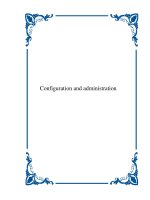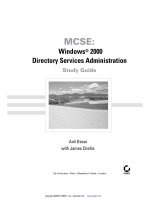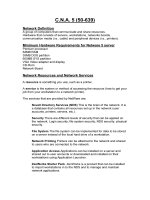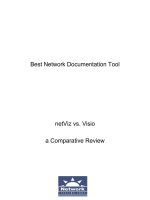Tài liệu OCP Network Administration pptx
Bạn đang xem bản rút gọn của tài liệu. Xem và tải ngay bản đầy đủ của tài liệu tại đây (2.68 MB, 292 trang )
30051GC10
Production 1.0
August 1999
M09125
Enterprise DBA Part 3:
Network Administration
Student Guide
Author
Sharaaz Khan
Technical Contributors
and Reviewers
Peter Kilpatrick
Bruce Ernst
Hanne Rasmussen
A. J. Vos
Mary Bryksa
Joel Goodman
Andrew Philips
Alexander Hunold
Publisher
Tommy Cheung
Copyright
Oracle Corporation, 1999. All rights reserved.
This documentation contains proprietary information of Oracle Corporation. It is
provided under a license agreement containing restrictions on use and disclosure
and is also protected by copyright law. Reverse engineering of the software is
prohibited. If this documentation is delivered to a U.S. Government Agency of the
Department of Defense, then it is delivered with Restricted Rights and the
following legend is applicable:
Restricted Rights Legend
Use, duplication or disclosure by the Government is subject to restrictions for
commercial computer software and shall be deemed to be Restricted Rights
software under Federal law, as set forth in subparagraph (c) (1) (ii) of DFARS
252.227-7013, Rights in Technical Data and Computer Software (October 1988).
This material or any portion of it may not be copied in any form or by any means
without the express prior written permission of Oracle Corporation. Any other
copying is a violation of copyright law and may result in civil and/or criminal
penalties.
If this documentation is delivered to a U.S. Government Agency not within the
Department of Defense, then it is delivered with “Restricted Rights,” as defined in
FAR 52.227-14, Rights in Data-General, including Alternate III (June 1987).
The information in this document is subject to change without notice. If you find
any problems in the documentation, please report them in writing to Education
Products, Oracle Corporation, 500 Oracle Parkway, Box SB-6, Redwood Shores,
CA 94065. Oracle Corporation does not warrant that this document is error-free.
Oracle is a registered trademark and trademarks or registered trademarks of
Oracle Corporation.
All other products or company names are used for identification purposes only
and may be trademarks of their respective owners.
Enterprise DBA Part 3: Network Administration iii
Contents
Introduction
Course Objectives I-2
Database Administrator Tasks I-4
Course Schedule I-5
Lesson 1: Networking Overview
Objectives 1-2
Network Environment Challenges 1-3
Network Configurations 1-5
Oracle’s Solutions 1-8
Summary 1-20
Lesson 2: Basic Net8 Architecture
Objectives 2-2
Overview 2-3
Basic Operations 2-4
Files and Locations 2-5
The Net8 Stack 2-10
Summary 2-20
Lesson 3: Basic Net8 Server-Side Configuration
Objectives 3-2
Overview: The Listener Process 3-3
The Listener Responses 3-4
Bequeath Session 3-5
Redirect Session (Dedicated) 3-6
Redirect Session (Dispatcher) 3-7
The LISTENER.ORA File 3-9
LISTENER.ORA File Parameters 3-12
Listener Configuration: Creation 3-14
Listener Configuration: Services 3-15
Listener Control Utility (LSNRCTL) 3-16
LSNRCTL Commands 3-17
Additional LSNRCTL Commands 3-18
iv Enterprise DBA Part 3: Network Administration
Contents
LSNRCTL SET and SHOW Modifiers 3-19
Automatic Instance Registration 3-21
Automatic Instance Registration: Parameters 3-22
Troubleshooting the Listener 3-23
Summary 3-25
Frequently Asked Questions 3-26
Lesson 4: Basic Net8 Client-Side Configuration
Objectives 4-2
Overview 4-3
Host Naming 4-4
Local Naming 4-6
Configuring Local Naming Using Net8 Assistant 4-7
Generated Files 4-16
New TNSNAMES.ORA Parameters 4-18
Connection Load Balancing 4-20
Connection Load Balancing and Failover: Example 4-22
Troubleshooting the Client Side 4-23
Summary 4-25
Frequently Asked Questions 4-26
Lesson 5: Centralized Naming Concepts
Objectives 5-2
What Is a Service Name? 5-3
Service Name Resolution Methods 5-4
Resolution with Local Naming 5-5
Resolution with Centralized Naming 5-6
Centralized Naming Using a Names Server 5-7
When to Use a Names Server 5-8
Oracle Names Directory Objects 5-9
Domain Naming Models: Flat 5-10
Domain Naming Models: Hierarchical 5-11
Names Server Dynamic Discovery 5-12
Client-Side Cache 5-13
Enterprise DBA Part 3: Network Administration v
Contents
Cache Replication 5-14
The Region Database 5-15
Summary 5-16
Lesson 6: Oracle Names Usage and Configuration
Objectives 6-2
Configuring Centralized Naming 6-3
Configuring the Names Server (Cache) 6-5
Configuring the Client Profile 6-11
Testing the Names Server 6-16
Configuring a Region Database 6-17
Names Control Utility (NAMESCTL) 6-20
NAMESCTL Commands 6-21
Other NAMESCTL Commands 6-24
NAMESCTL SET Modifier 6-26
NAMESCTL SHOW Modifier 6-27
Summary 6-29
Lesson 7: Multithreaded Server Usage and Configuration
Objectives 7-2
Server Configurations 7-3
Multithreaded Server Architecture 7-9
Configuring the Multithreaded Server 7-12
Data Dictionary 7-23
Connection Pooling 7-25
Summary 7-29
Lesson 8: Connection Manager Usage and Configuration
Objectives 8-2
Configuring Connection Manager 8-5
Summary 8-21
Lesson 9: Troubleshooting the Network Environment
Objectives 9-2
Overview 9-3
vi Enterprise DBA Part 3: Network Administration
Contents
Troubleshooting Checklist 9-4
TNSPING Utility 9-6
Net8 Assistant: Logging and Tracing 9-7
Listener Audit Trail 9-14
Logging and Tracing Components 9-15
Trace Assistant 9-18
Summary 9-21
Frequently Asked Questions 9-22
Lesson 10: Security in the Network Environment
Objectives 10-2
Overview: Network Security Risks 10-3
Data Privacy: Data Theft 10-4
Data Integrity: Data Modification 10-5
Data Integrity: Data Disruption 10-6
Compromised Authentication 10-7
Compromised Authorization 10-8
Network Security Solutions 10-9
Data Encryption 10-10
Cryptographic Checksumming 10-11
Configuring Encryption and Checksumming 10-12
Encryption and Checksumming Modes 10-13
Authentication 10-14
Enhanced User Authentication 10-15
Token Cards 10-16
Biometric Authentication 10-17
Kerberos Authentication 10-18
RADIUS Authentication 10-19
Configuring Authentication 10-20
Single Sign-On 10-21
Secure Sockets Layer 10-22
DCE Integration 10-23
Summary 10-24
Enterprise DBA Part 3: Network Administration vii
Contents
Appendix A: Practices
Practice 3 A-2
Practice 4 A-3
Practice 6 A-4
Practice 7 A-6
Practice 8 A-7
Practice 9 A-8
Appendix B: Practice Solutions
Practice 3 Solutions B-2
Practice 4 Solutions B-6
Practice 6 Solutions B-12
Practice 7 Solutions B-18
Practice 8 Solutions B-22
Practice 9 Solutions B-26
Appendix C: Configuring External Procedures
Configuring External Procedures C-2
viii Enterprise DBA Part 3: Network Administration
Contents
I
Introduction
I-2 Enterprise DBA Part 3: Network Administration
.
Introduction
Course Objectives
Copyright Oracle Corporation, 1999. All rights reserved.
Objectives
At the end of this course, you should be able to do
the following:
• Identify network trends and problems, and provide
solutions for them
• Define the Net8 architectural layers
• Configure a simple client and server, and establish
a connection between them
• Configure and start a Names server and use it to
resolve a service name
Enterprise DBA Part 3: Network Administration I-3
.
Course Objectives
Copyright Oracle Corporation, 1999. All rights reserved.
Objectives
• Configure and start up a multithreaded server
• Configure the Connection Manager and use it for
pooling connections and restricting clients from
connecting
• Analyze and troubleshoot Net8 problems using log
files, trace files, and Trace Assistant
• Identify network security risks and their solutions
and configure data encryption using the Oracle
Advanced Security option
I-4 Enterprise DBA Part 3: Network Administration
.
Introduction
Database Administrator Tasks
Scope of the Course
This course is the fourth in a series of four courses that cover the core database
administrator tasks. The tasks covered in this course are:
• Planning the network environment to address connectivity, performance,
and security issues
• Enabling network client-server, server-server, and middle-tier
connectivity
• Managing the network through administration utilities and tools
• Ensuring solid network integrity, privacy, authentication, and
authorization
• Invoking the tools needed for troubleshooting the network environment
DBA Tasks Covered in Other Courses
The following tasks are discussed in other courses:
• Database administration in Enterprise DBA Part 1A: Architecture and
Administration
• Backup and recovery in Enterprise DBA Part 1B: Backup and Recovery
• Database tuning in Enterprise DBA Part 2: Performance and Tuning
Copyright Oracle Corporation, 1999. All rights reserved.
Database Administrator Tasks
• Planning the network environment
• Enabling connectivity
• Managing the network
• Ensuring network security
• Troubleshooting the network
• Database administration
• Backup and recovery
• Database tuning
Enterprise DBA Part 3: Network Administration I-5
.
Course Schedule
Course Schedule
Agenda
The following is the recommended lesson schedule for this course:
Day 1
• Networking Overview
• Basic Net8 Architecture
• Basic Net8 Server-Side Configuration
• Basic Net8 Client-Side Configuration
• Centralized Naming Concepts
• Oracle Names Usage and Configuration (Theory)
Day 2
• Oracle Names Usage and Configuration (Practice)
• Multithreaded Server Usage and Configuration
• Connection Manager Usage and Configuration
• Troubleshooting the Network Environment
• Security in the Network Environment
Copyright Oracle Corporation, 1999. All rights reserved.
Suggested Course Schedule
Day Start End
1 Lesson 1 Lesson 5
2 Lesson 6 Lesson 10
I-6 Enterprise DBA Part 3: Network Administration
.
Introduction
1
Networking Overview
1-2 Enterprise DBA Part 3: Network Administration
Lesson 1: Networking Overview
Objectives
Copyright Oracle Corporation, 1999. All rights reserved.
®
Objectives
After completing this lesson, you should be able to
do the following:
• Identify networking business trends
• Describe Oracle networking solutions
Enterprise DBA Part 3: Network Administration 1-3
Network Environment Challenges
Network Environment Challenges
Configuring the Network Environment
To implement a successful networking environment consider the following questions:
• What type of network are you configuring? Is it a small network with a few clients,
or a more complex network with many clients and many servers?
• Are you using a single protocol or multiple protocols?
• Is the network static or expanding?
• What configuration options do you have?
• Are there user-friendly tools available to configure the network?
Maintaining the Network
• How much network maintenance is required for your enterprise?
• Will you add clients and servers to your network?
• Do you anticipate frequent upgrades?
Tuning, Troubleshooting, and Monitoring the Network
• Does your network include the needed tools?
• How large a workload do you anticipate?
– Number of users
– Number of transactions
– Number of nodes
– Location of nodes
Copyright Oracle Corporation, 1999. All rights reserved.
®
Network Environment Challenges
•
Configuring the network environment
• Maintaining the network
• Tuning, troubleshooting, and monitoring the
network
• Implementing security in the network
• Integrating legacy systems
1-4 Enterprise DBA Part 3: Network Administration
Lesson 1: Networking Overview
Implementing Security in the Network
• Do you need to secure your network environment?
• Is secure and sensitive information being transmitted over the network?
• What tools are available for implementing security?
Integrating Legacy Systems
How will your legacy systems interact with your networking environment?
Note: Performing an up-front analysis that answers questions like these helps you
choose the appropriate network strategy from the beginning.
Enterprise DBA Part 3: Network Administration 1-5
Network Configurations
Network Configurations
Two-Tier Networks
In a two-tier network, a client communicates directly with a server. This is also known
as a client-server architecture.
A client-server network is an architecture that involves client processes that request
service from server processes.
The client and server communicate over a network using a given protocol, which must
be installed on both the client and the server.
A common error in client-server network development is to prototype an application
in a small, two-tier environment and then scale up by simply adding more users to the
server. This approach can result in an ineffective system, as the server becomes
overburdened. To properly scale to hundreds or thousands of users, it may be
necessary to implement an N-tier architecture, which introduces one or more servers
or agents between the client and server.
Copyright Oracle Corporation, 1999. All rights reserved.
®
Simple Network: Two-Tier
Network
Client
Server
• Network connects client and server
• Client and server speak the same “language” or
protocol
1-6 Enterprise DBA Part 3: Network Administration
Lesson 1: Networking Overview
N
-Tier Networks
In an N-tier architecture, the role of the middle-tier agent can be manifold. It can
provide:
• Translation services (as in adapting a legacy application on a mainframe to a
client-server environment or acting as a bridge between protocols)
• Scalability services (as in acting as a transaction-processing monitor to balance the
load of requests between servers)
• Intelligent agent services (as in mapping a request to a number of different servers,
collating the results, and returning a single response to the client)
Copyright Oracle Corporation, 1999. All rights reserved.
®
Simple to Complex Network:
N
-Tier
Network
Middle tier
Network
• Client can be a thin client or a PC
• Middle tier can contain applications and services
• Server holds actual data
Client
Server
Enterprise DBA Part 3: Network Administration 1-7
Network Configurations
Complex Network Issues
Networks should improve communication rather than impede distributed operations.
In a more complex network environment, several issues must be addressed:
• Different hardware platforms that run different operating systems
• Multiple protocols used on these platforms
• Variable syntax issues between the different but connected applications
• Different geographical locations in which the connected applications reside
A well-designed complex network can support a large-scale distributed system.
Copyright Oracle Corporation, 1999. All rights reserved.
®
Complex Network
TCP/IP
AppleTalk
SPX/IPX
NetBIOS
DECnet
APPC/LU6.2
1-8 Enterprise DBA Part 3: Network Administration
Lesson 1: Networking Overview
Oracle’s Solutions
Copyright Oracle Corporation, 1999. All rights reserved.
®
Oracle’s Solutions
• Net8
• Oracle Names server
• Connection Manager
• Advanced Security option
• Open Gateways
Enterprise DBA Part 3: Network Administration 1-9
Oracle’s Solutions
Net8 Key Features
Net8 introduces key new features to address the changes occurring from the growth in
distributed environments. These changes include increasing user access to data stores,
creating more easily configured and administered environments, and enhancing user
authentication to securely identify users.
Copyright Oracle Corporation, 1999. All rights reserved.
®
Oracle’s Solutions: Net8
• Protocol independence
• Comprehensive platform support
• Integrated GUI administration tools
• Multiple configuration options
• Tracing and diagnostic toolset
• Open API
• Basic security
1-10 Enterprise DBA Part 3: Network Administration
Lesson 1: Networking Overview
Net8
Net8 provides the industry’s broadest support for network transport protocols,
including TCP/IP, Novell SPX/IPX, IBM LU6.2, and DECnet. All data conversion
using Net8 is invisible to the user and the application. This enables Oracle8i to operate
across different types of computers, operating systems, and networks to transparently
connect any combination of PC, UNIX, legacy, and other systems without expensive
changes to the existing infrastructure.
Net8 contains configuration and administration mechanisms and eliminates the need
for a centralized configuration utility. For simple environments, Net8’s default settings
provide a transparent name resolution adapter. This eliminates the need for generating
configuration files. For more complicated environments, Oracle Names server stores
connection information in a database or in a local data cache.
In Oracle8i, Net8 addresses Internet connectivity through integration of standard
solutions such as Remote Authentication Dial-In User Service (RADIUS) and
Lightweight Directory Access Protocol (LDAP) with legacy systems.
Copyright Oracle Corporation, 1999. All rights reserved.
®
Oracle’s Solutions: Net8
Protocol
Net8
Client
Server
Any platform Any platform
Administration and configuration
Protocol
Net8
Enterprise DBA Part 3: Network Administration 1-11
Oracle’s Solutions
IIOP and HTTP Connectivity
Connections to the database are not limited to Net8 alone; clients can establish
connections to the database using Internet protocols such as Internet Inter-ORB
Protocol (IIOP) and Hypertext Transfer Protocol (HTTP). Using these Internet
protocols, users can run applications from within a Web browser to connect directly to
an Oracle8i database. Internet technologies such as iFS (Internet File System),
Enterprise JavaBeans (EJB), and the Internet standard Secure Sockets Layer (SSL)
protocol provide added security to network connections.
Note: Net8 supports a new presentation layer called General Inter-ORB Protocol
(GIOP) that is used for clients that connect to the Java option. IIOP is an
implementation of GIOP over TCP/IP or TCP/IP with SSL. Oracle provides the GIOP
service implementation.
Copyright Oracle Corporation, 1999. All rights reserved.
®
Oracle’s Solutions: Internet Database
Connectivity
Web browser Oracle8i
IIOP, HTTP
In Oracle8i, database connectivity can be achieved
using the following additional protocols:
• Internet Inter-ORB Protocol (IIOP)
• Hypertext Transfer Protocol (HTTP)









